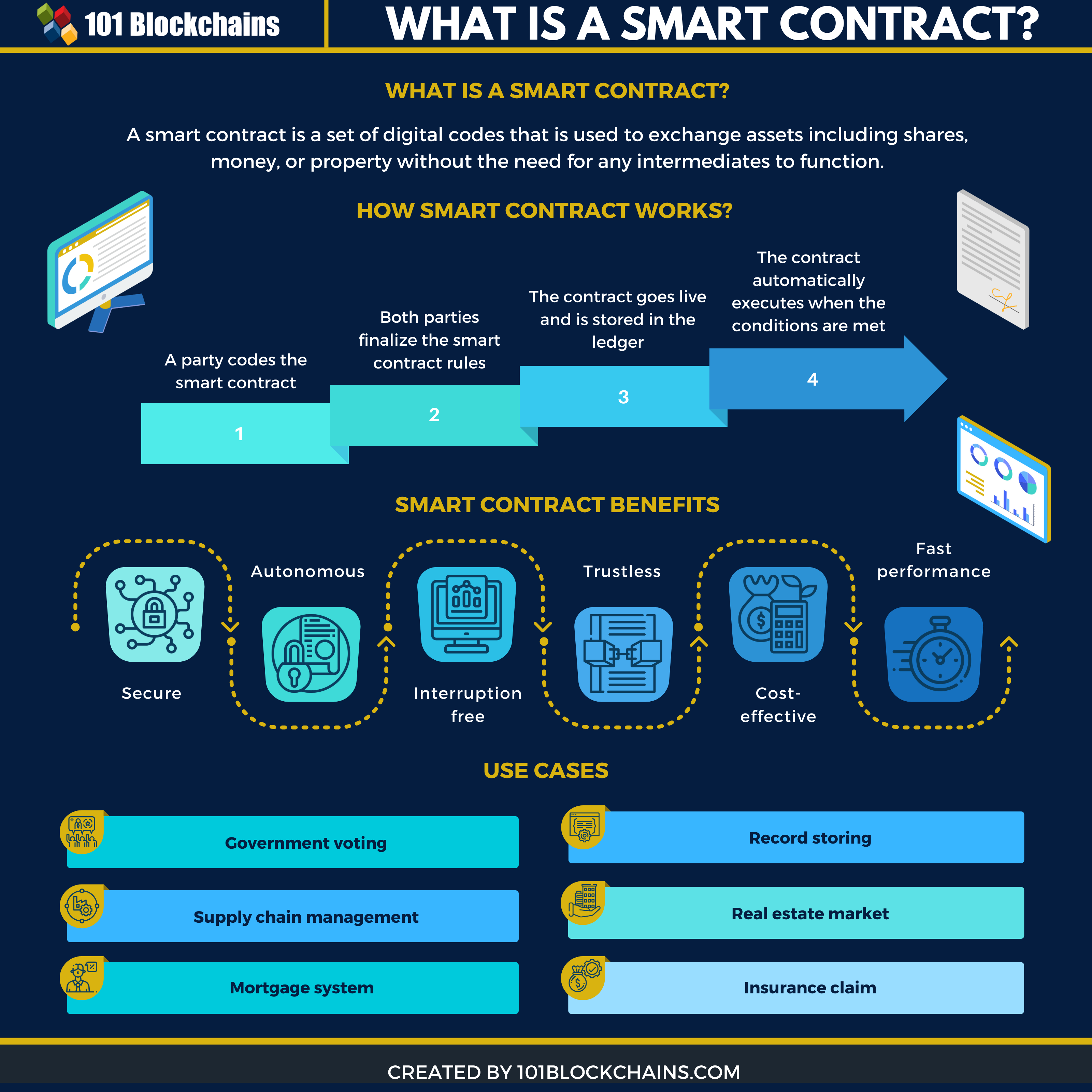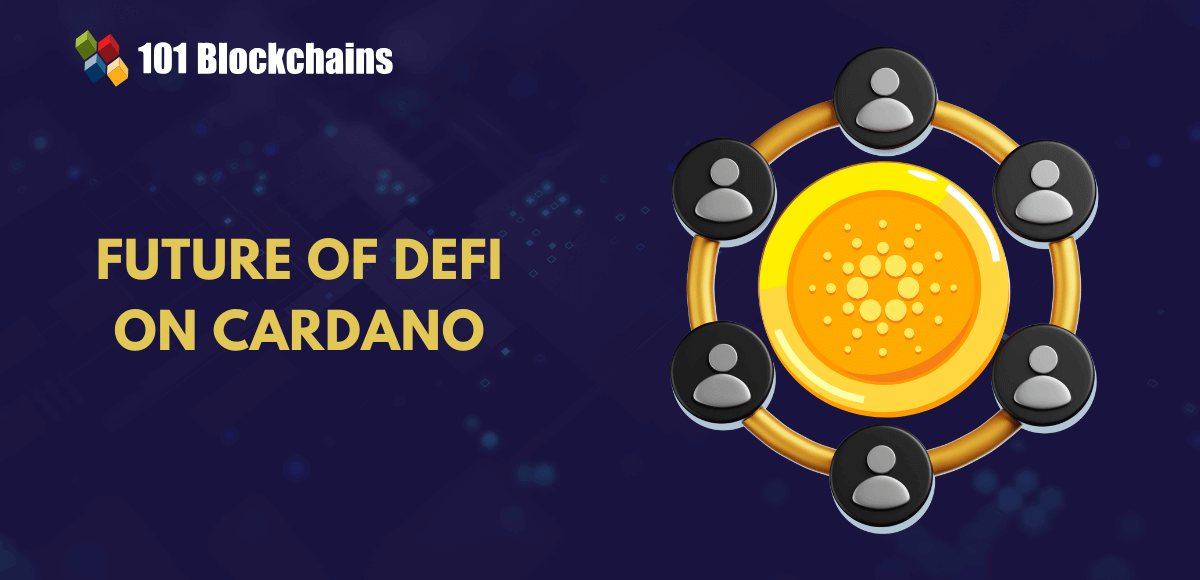Learn how blockchain truly works, master key definitions, and uncover what makes smart contracts so "smart." Dive into the fundamentals, gain valuable insights, and start your blockchain journey today!

- Solidity & Smart Contracts
Gwyneth Iredale
- on August 11, 2021
Top 5 Programming Languages to Build Smart Contracts
Wondering about which is the best language for your smart contract? Here we enlist the top 5 programming languages to build your smart contracts.
The demand for blockchain has been exploding profoundly in recent times. The global pandemic has shifted the world’s attention towards digitalization thereby forcing enterprises to search for efficient and secure approaches for transferring their existing business processes to digital platforms. Blockchain emerged as one of the prolific technologies with the value of security and transparency in transforming the conventional processes.
Smart contracts have been one of the most promising applications of blockchain technology with diverse functionalities. Therefore, the interest in smart contract programming languages has been increasing recently. The following discussion offers a detailed overview of the top five programming languages preferred for the development of smart contracts.
Curious to understand the complete smart contract development lifecycle? Join the Standard & Premium Plans and get free access to the Smart Contracts Development Course Now!
Demand for Smart Contracts
Before reflecting on the top smart contract languages, let us take an overview of the blockchain market. Leading market research firms have established that the global blockchain market would reach valuation of almost $39.7 billion by 2025. The prospects of blockchain adoption are considered favorable by almost 83% of CEOs according to a Deloitte global survey. Almost 53% of participants in the same survey perceived blockchain technology as a critical priority for transforming their business operations.
With smart contracts being one of the notable applications of blockchain, it is reasonable to find better career prospects in development of smart contracts. Smart contract languages can help in developing decentralized applications and digital contracts tailored to the requirements of organizations. However, it is quite difficult to round up on a specific assortment of programming languages as the best alternatives for smart contract development. Why? There are so many!
Build your identity as a certified blockchain expert with 101 Blockchains’ Blockchain Certifications designed to provide enhanced career prospects.
Want to get a deep understanding of Smart Contracts? Check out this detailed graphic –

Please include attribution to 101blockchains.com with this graphic. <a href='https://101blockchains.com/blockchain-infographics/'> <img src='https://101blockchains.com/wp-content/uploads/2020/08/what-is-a-smart-contract-1.png' alt='what is a smart contract='0' /> </a>
Top Smart Contract Languages
Smart contracts are basically self-executing contracts in the form of code which clearly specifies the terms of agreement between two parties. The code is present throughout a distributed ledger without the need for any central entity. So, it is clearly evident that you would need programming languages to write the code for smart contracts on the blockchain. Here is a detailed overview of some of the notable blockchain smart contract languages.
1. Solidity
The first entry among popular smart contract programming languages would obviously point towards Solidity. It is an object-oriented, high-level programming language tailored for the implementation of smart contracts. The applications of Solidity have been largely evident in the case of developing Ethereum smart contracts. As a curly-bracket language, Solidity draws prominent inspiration from other languages such as JavaScript, C++, and Python. In addition, it also targets the Ethereum Virtual Machine or EVM specifically. Another important feature of Solidity as one of the top smart contract languages is the support for inheritance alongside libraries as well as complex user-defined types. The statically typed programming language is suitable for creating smart contracts for use cases like,
- Voting
- Multi-signature wallets
- Blind auctions
- Crowdfunding
Solidity founds its roots under Gavin Wood, Yoichi Hirai, Christian Reitwiessner and many other core contributors of Ethereum. The primary objective of developing the language was to facilitate the creation of smart contracts which would work on Ethereum. Solidity is comparatively new among smart contract languages and has garnered over 200,000 developers as an object-oriented Turing-complete programming language.
With Ethereum presently leading the pack among smart contract platforms, many other blockchain networks are preferring Solidity-compatible smart contracts. The support for inheritance with Solidity can help in extending other contracts. Furthermore, libraries in Solidity can help in the creation of reusable code which you could easily call from various contracts, just like the static functions in a static class for object-oriented programming languages.
Solidity is easily one of the high-end smart contract programming languages, especially with the name of Ethereum. The similarities of Solidity with modern programming languages is one of the prominent value benefits for smart contract developers. The language is also referred to as Turing-complete, which implies that you could write code created in other languages. The portability of Solidity smart contracts to other blockchain networks also stands out as one of its prominent benefits. Some of the notable blockchain projects using Solidity include Ethereum, Compound Protocol, and Chainlink.
Want to learn more about The Ethereum Technology? Enroll Now: The Complete Ethereum Technology Course
2. Vyper
The next important answer to ‘What language are smart contracts written in?’ would point aspiring smart contract developers towards Vyper. It is a programming language with a heavy influence of Python tailored particularly for smart contract development. The three fundamental design principles and goals of Vyper provide a solid foundation for its efficiency in smart contract development. The three principles in the design of Vyper are,
-
Auditability
The foremost design principle and objective for Vyper is auditability, which should ensure that Vyper code is human-readable. In addition, auditability must also ensure that it is highly difficult to write any malignant code. Interestingly, the focus of Vyper as one of the top smart contract programming languages lies in simplicity for the reader. It also prioritizes readers with limited previous experience with programming.
-
Security
Another notable design principle of Vyper is the possibility of naturally developing smart contracts with better security. Security is one of the basic traits preferred in smart contracts and Vyper serves as an effective programming language for smart contracts for this sole reason.
-
Simplicity
The next important factor in the design principles of Vyper is the simplicity of the language and its compiler. It should focus on ensuring that the language and compiler implementation is simple and easy to understand.
As one of the reliable smart contract languages, Vyper offers the following features for smart contract developers.
- Vyper enables checking of bounds and overflow for on array accesses as well as arithmetic.
- The small and simple compiler code gives the perfect foundation for beginners to start learning the Vyper programming language.
- Vyper is also compatible with decimal fixed-point numbers and signed integers.
- Vyper programming language also enables strong typing.
- One of the striking features of Vyper as one of the top blockchain smart contract languages is the possibility for computing a precise upper limit for gas consumption related to a specific Vyper function call.
Additionally, the restricted support for pure functions with Vyper is also a favorable factor for smart contract development. It ensures that any entity classified as constant could not change its state.
Start learning Smart Contracts and its development tools with World’s first Smart Contracts Skill Path with quality resources tailored by industry experts Now!
3. Yul
Yul is another entry among popular smart contract programming languages. As a matter of fact, it is an intermediate language that you can compile to bytecode for addressing the needs of different backends. It is important to note that Yul bears planned support for EVM 1.0, Ewasm, and EVM 1.5. Basically, the design of Yul is suitable as a common denominator for all three platforms. It is possible to use Yul in stand-alone mode alongside ‘inline assembly’ within Solidity. Interestingly, you can also find an experimental implementation of Solidity compiler based on Yul as the intermediate language. It could easily serve as an ideal target for high-level optimization use cases which could address value benefits for different target platforms.
Yul is one of the promising answers to ‘what language are smart contracts written in?’ owing to its design goals.
- The design of Yul focuses on achieving better simplicity in the translation of code from Yul to bytecode.
- In addition, it also ensures easily understandable control flow for enabling improved manual inspection alongside optimization and formal verification.
- Another important aspect in the design goals of Yul is the emphasis on the readability of programs scripted in Yul. The readability of programs on Yul should be applicable even in cases where code is developed by a compiler from Solidity or other high-level languages.
- Furthermore, Yul also supports whole-program optimization.
The notable value advantages of Yul would include the following,
- Yul is able to achieve readability of programs and control flow by offering high-level constructs such as for loops, function calls, and if and switch statements. Although tailored specifically for stack machines, Yul does not bring out the complexity of the stack. As a result, the programmers or auditors do not have to be concerned about the stack.
- The ease of translation of Yul to bytecode comes with the compilation of the higher-level constructs to bytecode in a regular fashion. The statically typed nature of Yul also helps in avoiding confusion among concepts such as references and values.
- The effectiveness of Yul as one of the top smart contract languages emerges from its simplicity and flexibility. Without any in-built operations, types, or functions in the pure form, programmers get a simple and flexible language for creating smart contracts.
Presently, users could access only one specified dialect for Yul which leverages the EVM opcodes as in-built functions. The dialect helps in defining only the u256 type, which is a native 256-bit type of EVM.
Want to get an in-depth understanding of Solidity concepts? Join the Standard & Premium Plans and get free access to Solidity Fundamentals Course Now!
4. DAML
DAML (Digital Asset Modelling Language) is another top entry among blockchain smart contract languages. It is an open-source programming language that is used to write distributed applications in correct, quick, and concise manner. More precisely, DAML is an easy, safe, and efficient smart contract language. DAML is mainly intended for distributed ledgers. It provides high-level and unambiguous specification of business logic in real-time.
As distributed applications are not simple but one of the latest emerging trends, traditional languages are not able to perform up to the mark. There are many complexities in distributed applications such as distributed state synchronization and cryptography that need a ground-up approach. DAML is ahead of the curve, thus can meet all the high-level requirements of building distributed applications.
Important points you should know about DAML are:
- DAML is a language of contracts
- DAML is a functional language
- DAML is a language of ledgers
- DAML is a language of privacy
DAML is used by programmers to explain about the contract formation, involved parties, and the parties which authorized the contract formation. While using DAML, the developers can focus on the business logic instead of focusing on how to convert the ideas into code. DAML does all i.e. it expresses parties, contracts, obligations, rights, and authorization directly.
DAML comes with a toolkit for developers that consists of:
DAML IDE – It’s the Integrated Development Environment used for getting feedback on privacy, authorization, and the application behaviour.
DAML Assistant – It’s the Command Line Interface (CLI) responsible for creating, initializing, compiling, and building applications.
DAML Sandbox – It’s the simple ledger that empowers a rapid application prototyping without the requirement of an infrastructure.
Integrations – You just focus on describing your application behaviour in an easy to read-write smart-contract language and DAML will handle integrations and infrastructure.
5. JavaScript
The popularity of one of the renowned smart contract languages, Solidity, largely rests on its similarities to JavaScript. From the brain of Brendan Eich, the creator of Mozilla Firefox and Brave browser, JavaScript revolutionized programming. It offered a lightweight, object-oriented, dynamic programming language. As a matter of fact, JavaScript is one of the foundational pillars for web designing alongside HTML and CSS forms. A simple online search could help you find that HTML could help you enter content on your website. At the same time, CSS could support you in creating the design layout. However, what does this have to do with the role of JavaScript in smart contract programming?
In order to understand JavaScript as one of the blockchain smart contract languages, it is important to know that it introduced dynamic and user-friendly websites. Initially, the design of JavaScript had to focus on serving as a client-side script. However, different implementations of JavaScript such as node.js have encouraged the possibilities for server-side implementations also. When smart contracts based on Ethereum depend on specific languages for improved completeness and correctness, JavaScript can address ancillary work.
For example, if smart contract developers want to create tools for tracking contracts and translating their states to simple, human-readable websites, Web3 can be a reliable suggestion. Web3 serves a collection of JavaScript objects with the facility of seamless and flexible interactions with the blockchain. It can enable programmers to write code with the functionalities for tracking contracts alongside maintaining their activity with gas.
The notable value advantages of JavaScript as one of the smart contract programming languages include the following,
- JavaScript ensures easier and faster entry to the market due to the ease of using solutions based on JavaScript.
- The design of JavaScript allows the benefit of improved scalability which can enhance the functionality of smart contracts effectively.
- Developers could capitalize on the support of multiple JavaScript frameworks according to the desired use case.
- Most important of all, JavaScript provides the assurance of limited hassles in the integration of required resources.
- As a result, JavaScript can be one of the top contenders among the smart contract languages outlined in this list.
Making the Decision
The five different programming languages recommended for smart contracts come with unique advantages. Interestingly, the list also includes a language that has not been released yet, although with promising potential. The point is, selecting the right programming language for developing smart contracts is all about choosing the right tool for the right job while satisfying your personal preferences. All of the smart contract programming languages in this discussion showcase promising potential in different areas.
Solidity offers the facility of many tutorials and learning tutorials for beginners alongside the support of a massive developer community. Vyper, on the other hand, provides ease of human readability and auditability. Most important of all, Vyper is a promising language for Python developers to start creating smart contracts. Yul provides the benefits of a functional and simple low-level language while DAML shows how to deal with the complexities of distributed applications. JavaScript ensures improved usability of smart contract solutions alongside serving as a suitable candidate for ancillary tasks in smart contract development.
With so many advantages, it is quite difficult to round up on a specific choice of smart contract programming language. At the same time, it is also implausible to consider any programming language as the most suitable alternative for smart contract development. Learn more about smart contracts and find more about the possibilities of using other programming languages for creating smart contracts.
Enroll Now for Blockchain Certification and Courses to start your career in blockchain technology!







